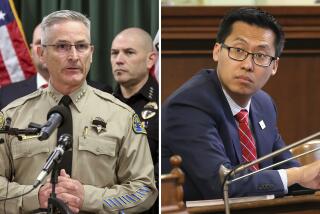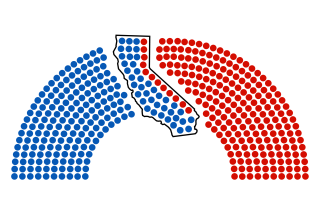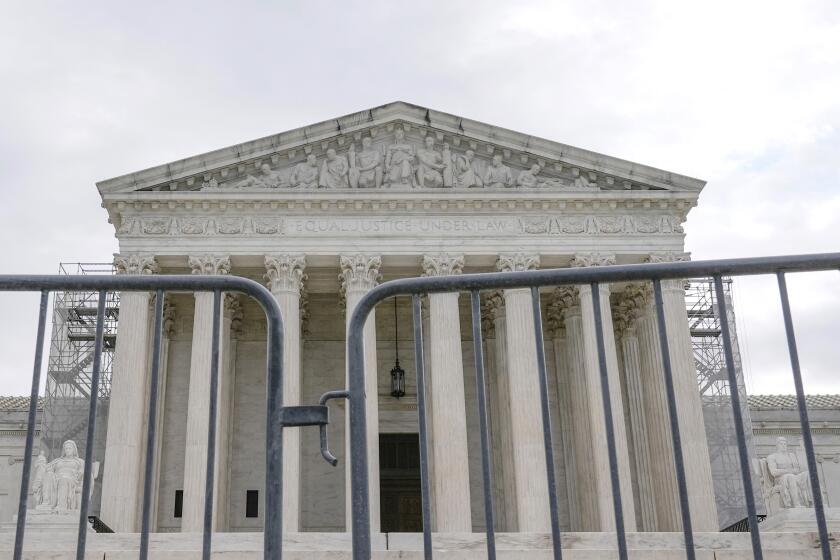Democrats’ State Senate Edge May Narrow
In three hotly contested races important for control of the Legislature, Republicans jumped off to early leads in districts long held by Democrats.
Returns in most parts of the state, however, were slow, and the battle for the Legislature was expected to go late into the night.
Along the Central Coast, moderate Republican Assemblyman Bruce McPherson of Santa Cruz edged ahead of former Democratic Assemblyman Rusty Areias of Carmel in a state Senate contest. They were vying for the seat held by retiring Sen. Henry Mello (D-Watsonville).
Elsewhere in Northern California, Assemblyman Richard Rainey (R-Walnut Creek) seized a narrow lead in early returns over Contra Costa County Supervisor Jeff Smith, a Democrat heavily backed by Senate President Pro Tem Bill Lockyer (D-Hayward). Democrats were battling to retain the seat held by retiring Sen. Dan Boatwright (D-Concord).
In a spirited Assembly contest in the 26th District in the Central Valley, Republican Thomas Berryhill, an agricultural businessman and son of a former lawmaker, had a narrow lead over Democrat Dennis Cardoza, a businessman. The seat has been held by Assemblyman Sal Cannella (D-Ceres), who was barred by term limits from seeking reelection.
Despite the inroads Republicans were making in the Senate’s Democratic majority, Lockyer was expected to keep his grip on the reins of power in the upper house.
The early returns in the Assembly were also providing good news to Republican Speaker Curt Pringle of Garden Grove.
In addition to Berryhill’s lead, the GOP was winning in a race that Democrats had targeted. Peter Frusetta of Tres Pinos was holding a substantial lead over Democratic challenger Lily Cervantes, a Santa Cruz County prosecutor strongly backed by organized labor and Latino lawmakers. This was a rematch of their 1994 contest, which Frusetta narrowly won.
Besides the two Northern California contests, Republican control of the Assembly was expected to be decided in a handful of battleground districts in Pasadena, San Diego and Long Beach. Both parties amassed millions of campaign dollars, targeting swing areas with overlapping legislative and congressional contests to maximize their donations to bankroll mailers, TV ads and get-out-the-vote efforts.
Democrats were beneficiaries of money and volunteers from organized labor, which was trying to prevent a repeat of the national 1994 GOP landslide.
In the wake of a court-approved redistricting and changes prompted by legislative term limits, Republicans in California two years ago gained control of the lower house for the first time in a quarter of a century. Only after months of maneuvering did they finally force longtime Democratic Speaker Willie Brown of San Francisco to relinquish the reins of power.
Charles Price, a Chico State political science professor, said that if Pringle succeeded in keeping his majority it would suggest a change in legislative politics long dominated by Democrats.
“If the Republicans are able to hold onto the Assembly, it would be indicative of a new kind of trend, of very competitive legislative races in California,” said Price, author of a textbook on California government.
“The Senate is obviously going to stay Democratic by a fairly safe margin,” he said. “It’s the Assembly where there’s a 50-50 chance” that the Democrats could narrowly return to power.
At stake in both houses is who will name committee chairmen, hire staff and control the agenda on pressing issues such as welfare reform, education spending and crime.
After staunch conservative Pringle took charge, for example, Republican-inspired legislation, long bottled up by Democrats, passed the Assembly. But the bills were typically derailed by Lockyer-led Democrats in the Senate.
On Tuesday, all 80 Assembly seats and half the Senate’s 40 seats were up for grabs.
In the Assembly, there were 33 open seats and 47 incumbents battling for reelection. Currently, the breakdown is 41 Republicans, 36 Democrats, one Reform Party member and two vacancies in seats considered safely Democratic.
In the 40-member Senate, 10 incumbents were seeking reelection and there were 10 open seats. The current partisan lineup is 22 Democrats, 16 Republicans and two independents who often side with Democrats.
Senate GOP leader Rob Hurtt of Garden Grove last year conceded that Republicans would not seize control of the upper chamber this election, but he consistently forecast a net gain of at least one and possibly two seats for the GOP, which hasn’t controlled the Senate in 25 years.
“We still think that one or two is realistic,” a Republican tactician said as the party marshaled its forces to get out the vote.
The election Tuesday cast Hurtt, a wealthy Orange County industrialist, and Lockyer in their first head-to-head general election fight since each took command of his party in the Senate.
“The worst possibility is no change [for Democrats], and it could go up by one,” said Lockyer as he handicapped the Senate contests.
Both sides zeroed in on five districts as crucial to the outcome, pouring millions of dollars into campaigns for jobs that pay $72,000 a year plus a tax-free expense allowance. Analysts believed that the total campaign bill for all 20 upper chamber seats at stake would probably exceed $10 million.
Besides the two Northern California districts, the top targets included:
* The traditional Republican stronghold in the 21st Senate District in Los Angeles County, where Democrat Adam Schiff, a former assistant U.S. attorney, counted on a new edge in Democratic registration to put him in the seat of retiring Sen. Newton R. Russell (R-Glendale). Schiff faced Assemblywoman Paula Boland (R-Granada Hills), who has represented a San Fernando Valley district for six years until being forced out by term limits.
* The 27th Senate District race, rated as a tossup by most campaign analysts, where freshman Assemblyman Phil Hawkins (R-Bellflower) battled against former Assemblywoman Betty Karnette (D-Long Beach). The region had been represented by retiring Sen. Bob Beverly (R-Long Beach).
* Assemblywoman Deirdre “Dede” Alpert (D-Coronado), challenged by Republican businessman Joe Dolphin, president of the state Community Colleges Board of Governors, in the 39th Senate District. The seat had been held for six years by Sen. Lucy Killea of San Diego, a Democrat-turned-independent.
Among Los Angeles-area incumbents, Sens. Tom Hayden (D-Los Angeles), Cathie Wright (R-Simi Valley) and Richard Mountjoy (R-Monrovia) did not face major opposition.
On the Assembly side, the current lineup of 10 Latinos, all Democrats, was expected to grow by at least two, including the first Latino Republican since the turn of the century.
Democrats were being led in the campaign by lame-duck Assemblyman Richard Katz of Sylmar, who was prohibited by term limits from seeking reelection. Several Los Angeles lawmakers, including Assemblywoman Sheila Kuehl and Assemblyman Kevin Murray, were among those poised to succeed Katz as the lower house’s Democratic leader.
On the eve of the election, Assembly Democrats said they had spent about $4 million--twice as much money as they had anticipated when the election season began.
Both sides were guardedly optimistic about their prospects.
But John Nelson, Pringle’s press secretary, said that whichever side comes out ahead, the margin will be narrow.
“It’s no longer going to be lopsided. What that means is you have battleground districts . . . you have to go after,” Nelson said.
Among the hotly contested Los Angeles-area seats were:
* The 44th District, which includes parts of the San Gabriel and San Fernando valleys, where conservative William Hoge (R-Pasadena) was locked in a neck-and-neck contest against Democratic challenger Jack Scott, former president of Pasadena City College.
* The GOP stronghold in the 43rd District in Glendale and Burbank, where Republican businessman John Geranios and Democrat Scott Wildman, a teacher, ran for a seat being vacated by Assemblyman Jim Rogan (R-Glendale), who sought to move to Congress.
* The 53rd District in the South Bay, where two-term Democrat Debra Bowen of Marina del Rey faced a strong challenge from Republican Dan Walker, a Torrance city councilman.
* Next door in the 54th District, which stretches from the Palos Verdes Peninsula to Long Beach, where Republican freshman Assemblyman Steve Kuykendall was challenged by Democrat Gerrie Schipske, a former Long Beach Community College trustee.
Besides Frusetta’s 28th District, the most closely watched Assembly races included:
* The 76th District in San Diego, where first-term Democrat Susan Davis was also in a rematch with Republican businessman Bob Trettin.
* The nearby 78th District, where former Republican Assemblywoman Tricia Hunter battled Democrat Howard Wayne, a deputy attorney general. Two other candidates were also mounting 11th-hour campaigns aimed at Hunter. One was an American Independent Party candidate on the ballot and the other a Coronado homemaker who was mounting a write-in effort financed by antiabortion forces.
* The 30th District in Fresno, where maverick Republican Brian Setencich, who served briefly as Assembly speaker last year, mounted a write-in campaign against Republican Robert M. Prenter Jr., a medical accounts representative who won the GOP primary last March.
More to Read
Get the L.A. Times Politics newsletter
Deeply reported insights into legislation, politics and policy from Sacramento, Washington and beyond. In your inbox three times per week.
You may occasionally receive promotional content from the Los Angeles Times.






